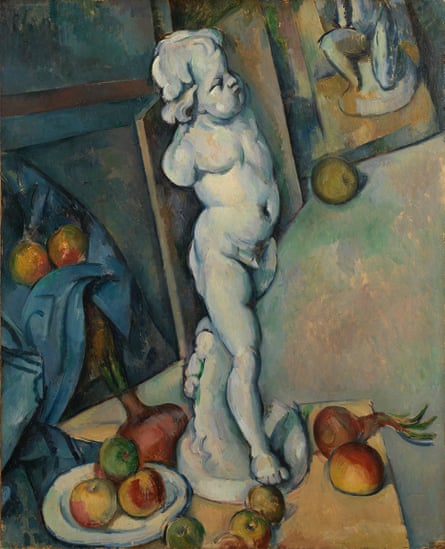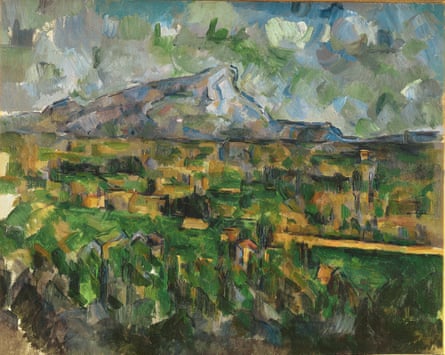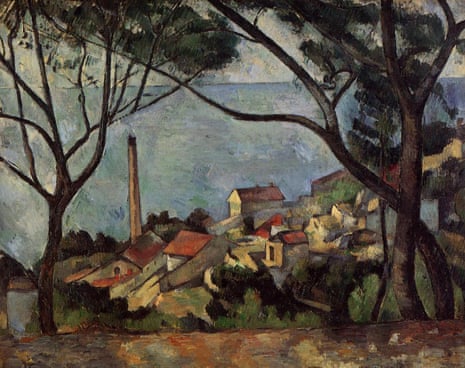Paul Cézanne’s sketchbook lies open at a childish drawing of a tall bendy house. It turns out he often let his little son use it. This openness to child’s play says a lot about the man, and not only as a parent. For Cézanne was the first western artist since the middle ages to claim a child’s freedom to depict things exactly as they pleased.
All around the glass case containing this sketchbook are Cézanne’s paintings of blocky houses overlapping in patterns of squares and triangles, coloured brown and yellow. These are the buildings of L’Estaque, a seaside village just west of Marseille, where Cézanne often stayed with his family – and where he invented cubism. As early as 1878, in The Sea at L’Estaque behind Trees, house walls and rooftops form a jagged cluster of flat yet rugged forms like the abstracted glances of objects that Pablo Picasso and Georges Braque would get nicknamed cubists for painting 30 years later. They were proud to claim the influence. Look at the label and you’ll see this has been lent from the Musée National Picasso-Paris, for it was owned by Pablo. Braque, for his part, painted his breakthrough cubist canvases in 1908 in L’Estaque itself, in direct homage to Cézanne.
Yet it isn’t just in massing cubistic houses that Cézanne blows tradition apart in his patient, quiet way. The Bay of Marseille, Seen from L’Estaque, painted in about 1885, takes so many liberties your brain gets dizzy. Beyond the diamond-shaped factory chimney is a blue sea that seems as hard as quartz. While the water looks solid, the hills beyond seem to be molten. Painting can refashion the very substances of things, says Cézanne. It is wilful and subjective, like a child’s sketch. And it’s fun to do.

Cézanne the fun guy? For a long time after his death in 1906, he was the ultimate icon of seriousness in art, his paintings analysed as philosophical conundrums, his legacy claimed by the most intense avant garde pioneers. Yet there’s a sly playful humour at the heart of his genius.
For instance, are you sure that still life is so still? Cézanne paints arrangements of bottles, dishes and fruits that not only seem at risk of tumbling as they balance on table edges, but in many cases can’t possibly be static in the way he shows them. In his 1893-4 Still Life With a Ginger Jar and Eggplants, a lemon is suspended in space, its yellow form clearly standing proud of the blue drapery that flows downward like a waterfall. Here you see how Cézanne inspired Matisse, for he can define form purely with colour, in ways that free objects from gravity. In the same painting, a plate of pears is tipped sideways, sliding towards the blue void, yet somehow staying in place.

He is having a laugh, surely. It looks as if he is playing boules in curved space-time with his apples. And it is not only the laws of physics he makes jokes about. Still Life With Plaster Cupid (c1894) not only features an apple refusing to roll down a steep slope but also two onions with long sprouting leaves, positioned so they allude to the missing phallus of a plaster-cast Cupid.
This gag is a reminder that, for all the virtuosity and authority of Cézanne’s later art, he was still the troubled bohemian he had been in his youth. The show starts with a puzzle: one of Cézanne’s noblest mature still lifes is juxtaposed with an insecure, uneasy self-portrait from about 1875, looking at us weakly set against pink wallpaper. How did this man produce that art?
Born in Aix-en-Provence in 1839, Cézanne went to school with Émile Zola who went on to invent the naturalist novel. And Cézanne’s own early art is just as raw. In The Murder (1867-70) one large figure holds a woman down with fleshy arms while the other raises a knife to stab her. It looks even more as if Cézanne might be processing psychological problems in The Eternal Feminine, from about 1877, in which a nude woman sits enthroned, bleeding from her blinded eyes and surrounded by a grotesque crowd of male worshippers, including an artist.
Young Cézanne expresses depraved thoughts about sex and death as freely as the poet and critic Baudelaire, who argued that “the painter of modern life” should be an observer of the contemporary. The Negro Scipio, a painting of a black male model from 1867, dwells on the man’s furrowed back in a way that artist Ellen Gallagher argues, in a catalogue essay and wall text, may be intended to suggest the flogged back of an enslaved man.
It’s conventional to tell a story of Cézanne’s development from such turbulent early work to his calm, disciplined later achievement, yet nudity never stopped fascinating him – and his images of naked people never did settle into sophistication. A whole room of his later nudes shows him still obsessing over awkward visions of female flesh in his 1885-87 painting Five Bathers, in which a group of women created by his imagination come together just for him in a fuzzy melting landscape. And in Bathers, from 1890-92, a gang of young men do the same.

These are not real nudes but dreams forged in the midday heat of Provence. Just as Cézanne’s seas are rock hard and his lemon floats in midair, his bathers are his most intense assertion that art creates, not copies, the world.
And yet there is a world. If Cézanne began by lashing out at reality with paint, he ends up discovering that the only truth he can know is his own. Each fractured brushstroke of the paintings of Mont Sainte-Victoire that are this show’s devastating finale is a document of the subjective way we all see and understand the world. But the mountain itself is always there – a huge solid chunk of fact. It obsesses him for reasons we can only guess. The beautiful, touching thing about this artist is how he takes apart reality without ever ceasing to care about it. This makes looking at his art one of the most heightened and extraordinary experiences you can have in a gallery – or anywhere.

Comments (…)
Sign in or create your Guardian account to join the discussion